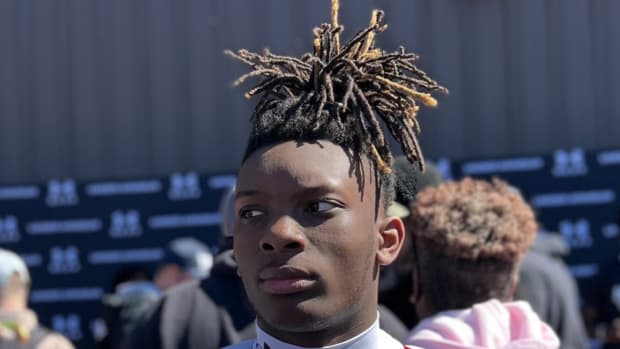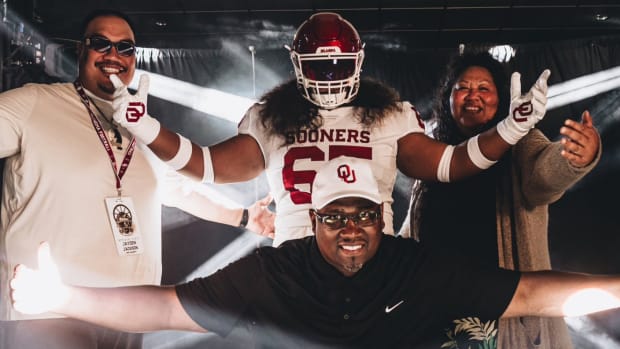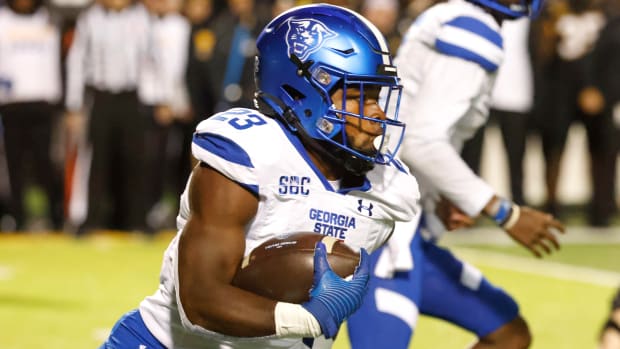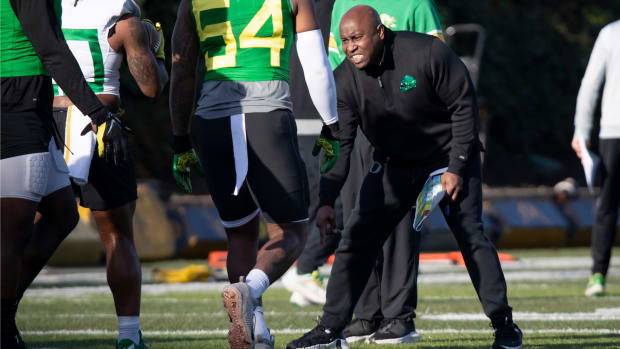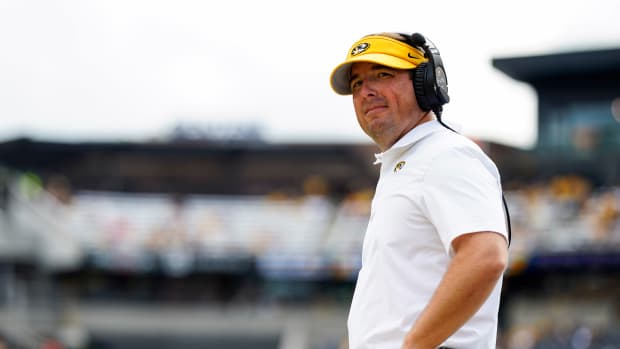After Its NFL Draft Bounceback, the Big 12 Sees an Encouraging Path Forward
After the NFL draft a year ago, it felt like the Big 12 was in a dark place. The league hadn’t put a team in the College Football Playoff in the 2016 season. It had produced fewer draft picks than any league in the Power 5 by a wide margin, and those players had been drafted lower than their Power 5 counterparts by a wide margin. Even worse, the Big 12 had produced fewer draft picks than the American Athletic Conference, the league whose members the Big 12 had goaded into an expansion dog-and-pony show only to yank away the money-stuffed football—Lucy and Charlie Brown–style—at the last moment.
You have reached your limit of 4 premium articles
Register your email to get 1 more
Still, the Big 12’s balance sheet was robust despite two near implosions in the previous seven years. The only threat to its long-term survival would be an inability to make the playoff and an inability to produce draft picks, because in the chicken-egg game of college football recruiting, a demonstrable lack of draft picks can become the albatross that keeps the best high-schoolers from signing with schools in the league.
“I think it's an easy target,” commissioner Bob Bowlsby said of the league’s football reputation last August. “I think it’s a perception, not a reality.”
Unfortunately for the Big 12, the draft issue was all too real. The numbers explained the reality, and the perception was built from that. The good news for the Big 12? The newest data are quite positive, and some repeat performances over the next few years could place the league in an entirely new reality at the perfect time.
The athletic directors and coaches of the Big 12 should feel much better today than they did a year ago. League champ Oklahoma made the playoff, and while the Big 12 still produced the fewest draftees of any Power 5 league with 20, its draftees per school rose from 1.4 in 2017 to two this year. But that’s not the most important number. The best news the Big 12 got was where the league’s players got drafted—starting with Sooners quarterback Baker Mayfield at No. 1.
The median draft position for Big 12 players this past weekend was 118. That’s a massive improvement over last year, when the midpoint of the Big 12’s draft distribution crashed to 140. As disturbing as getting beat by a Group of Five league in producing draft picks might have been, that number did even more damage because it allowed the SEC, Big Ten and Pac-12 schools that routinely recruit in Houston and Dallas to prove that signing with a Big 12 school could cost a recruit money in the long run.
The Big 12’s situation last year looked so dire because its draft profile looked more like the American’s than it did the other Power 5 leagues. The American’s median draft position was only three spots behind the Big 12’s. Meanwhile, the Big 12 came in more than two dozen spots behind the SEC and Big Ten.
This year, that median draft position distribution looks much better for the Big 12.
SEC: 105
Big Ten: 110
Big 12: 118
ACC: 128
Pac-12: 134
American: 174
As Big 12 coaches and ADs argued last year when things looked bad, these things tend to be cyclical. So how do we know whether this improvement is the start of a trend or a one-year anomaly?
We don’t. Simply looking at what each team lost from last season suggests a step back next year. West Virginia, which has a host of potential draftees led by quarterback Will Grier, receiver David Sills V and linebacker David Long, brings back a lot of talent. But stalwarts Oklahoma, Oklahoma State and TCU must replace key players all over the field. The good news for the Big 12 is that those are three of the best recruiting and development programs in the league. Oklahoma State’s Mike Gundy and TCU’s Gary Patterson have proven they can develop NFL players, and Oklahoma coach Lincoln Riley seems to have picked up where Bob Stoops left off.
Meanwhile, Texas had an offensive lineman drafted (Connor Williams to the Cowboys at No. 50) for the first time since 2008, and there seem to be others in the pipeline. Even if he didn’t win enough, Charlie Strong did upgrade the Longhorns’ talent base. Tom Herman and his staff locked down the state’s best in this year’s recruiting class, and their track record of developing players is good. So is Baylor coach Matt Rhule’s. The Bears, with a roster gutted following two years of scandal, went 1–11 last year. They’ll get better, and Rhule’s preferred offensive style might seem more attractive to NFL teams than the previous regime’s. The Art Briles offense scored a ton of points and won games at the college level, but quarterbacks, offensive linemen and receivers faced a steep learning curve in the NFL. Rhule’s preferred offense requires more teaching on the front end, but it may also prove more attractive to NFL GMs worried about the skill sets of linemen and receivers coming out of the scheme.
Meanwhile, the NFL seems to be more willing to adjust—to a point—to what colleges are producing. The Patriots incorporated Air Raid principles into their offense years ago. The Chiefs have overhauled their offense to accommodate former Texas Tech quarterback Patrick Mahomes. The Eagles won a Super Bowl by sprinkling in run-pass option plays that Austin-bred quarterback Nick Foles ran to perfection. The Rams altered their offense to suit former Air Raid quarterback Jared Goff. The Texans modified their offense to suit Deshaun Watson, who ran an uptempo spread at Clemson that was originally designed by former Tigers offensive coordinator Chad Morris, a former Texas high school coach. The selection of Mayfield—a quarterback from an Air Raid system who was given far more responsibilities than most Air Raid quarterbacks—over quarterbacks who had played in more pro-style offenses (USC’s Sam Darnold, Wyoming’s Josh Allen, UCLA’s Josh Rosen) suggests the preferred style of offense in the Big 12 is no longer a detriment in the draft.
This development bodes well for the Big 12 because if it can keep producing these kind of draftees and if it can continue making the playoff, the popular notion that the league will be ripped apart in the next round of realignment may disappear. The Big 12 is stronger financially than the Pac-12, where the wholly owned conference network hasn’t produced anywhere near the money schools were sold on when they tried to raid the Big 12 to start it. The Big 12 is on par with the ACC, though it remains to be seen how much difference the ACC Network—scheduled to launch next year—will make. Everyone is chasing the Big Ten and the SEC, and that isn’t likely to change.
If there is to be more realignment—and that isn’t guaranteed now that cable television isn’t driving the train anymore—then talks would begin to heat up near 2022. The Big Ten’s Tier 1 deals with Fox and ESPN expire at the end of the 2022–23 school year. (Big Ten commissioner Jim Delany has hedged well, going short with this six-year deal and long with the Big Ten Network deal, which runs through 2032.) The Pac-12’s Tier 1 deals expire at the end of the 2023–24 school year. The Big 12’s deal, along with the Grant of Rights that keeps the schools tethered to one another, expires the following year. If when all this happens the members of the Big 12 are happy financially and the football teams are competing for national titles and producing quality draft picks, the Big 12 will be just fine*.
*Texas remains the biggest prize in the Big 12 stable, but the Longhorns are quite limited in where they could go if they wanted to leave. Because ESPN owns the Longhorn Network, Texas could likely only go to a league whose rights are wholly owned by ESPN. The ACC is the only one that fits the bill. Also, Texas has a great deal in the Big 12 that probably couldn’t be replicated anywhere else.
A year after a draft that seemed to portend doom, everything looks rosier in the Big 12. The league will have to stay on this upward trajectory to keep the good vibes flowing, but the path is clear.
A Random Ranking
I’ve been eating a lot of omelets lately, so it’s time to rank the best omelet fillings.
1. Bacon
2. Steak
3. Cheddar cheese
4. Jalapenos
5. Avocado
6. Sausage
7. Green chile sauce
8. Ham
9. Mushrooms
10. Spinach
Three and Out
1. Former Ole Miss quarterback Shea Patterson will be eligible to play immediately for Michigan. But please don’t drop savior expectations on him immediately. He’s going to need help to make the offense effective.
2. Jon Wilner of Bay Area News Group goes back and examines the roots of the impasse between the Pac-12 Network and DirecTV.
3. Clemson coach Dabo Swinney would like to play Georgia every year, he told The (Columbia, S.C.) State last week. The Tigers already play South Carolina out of conference every year and the Bulldogs already play Georgia Tech, but it would make for a fantastic rivalry given how good Clemson has been and how good Georgia looks like it will be under Kirby Smart. The Bulldogs and Tigers played annually from 1962 to ’87 and most recently split a home-and-home series in 2013 and ’14, and both have been willing to add another challenging out-of-conference opponent most years in addition to their respective in-state rivals. The schools also are only 77 miles apart, making it one of the easiest road trips ever for a premium out-of-conference game.
What’s Eating Andy?
The Ravens’ selection of quarterback Lamar Jackson with the final pick of the first round seems to mean the team hopes to make Jackson the heir apparent to Joe Flacco. So the dumbest sports talk radio conversation will stop asking “Should Lamar Jackson play receiver?” and start asking “Is Lamar Jackson elite?”
What’s Andy Eating?
The reason I always lose weight over the summer is because of about a two-month period that requires almost no travel for work. That’s just how the college sports calendar works. During those two months, I can control what I eat with extreme precision. I can count every calorie and plan meals down to the minute.
On the road, it’s a different story. That’s why I tend to balloon during the rest of the year. I wind up pigging out most days for one of two reasons.
• I see something delicious that I’m not sure I’ll get to try again—or at least for a few years.
• I’ve worked for 12 hours straight with minimal food and I make up for this by ordering one of everything.
So I’m trying to find places that can be delicious and healthy at the same time so I don’t fall into one of these traps. The great Dan Rubenstein of the Solid Verbal Podcast introduced me to one such place in New York last week. Seamore’s is the brainchild of Michael Chernow, who also co-founded The Meatball Shop. The concept at The Meatball Shop is as simple as it is ingenious. They make meatballs in multiple varieties. You can get them plain or on a salad or inside a meatball sub. The only other major choice you have to make is what kind of cookies and ice cream you’d like to use to craft your ice cream sandwich for dessert.
Needless to say, I’ve been to The Meatball Shop a few times. But I needed something less caloric, and Seamore’s is almost as simple and just as tasty. The centerpiece of Seamore’s menu is The Reel Deal. Choose one of four rotating fresh catches (I chose redfish). Choose a sauce (I chose miso brown butter). Then choose three vegetables (I chose charred broccoli, braised chard and sautéed mushrooms.)
What arrived was a bowl of fresh, perfectly cooked food that wouldn’t make me fatter but would thrill my taste buds. The sauce comes on the side, so don’t worry about your fish drowning in calories. Plus, my redfish didn’t need any sauce. It was lightly seasoned and cooked tender. The broccoli was crisp, and the chard—cousin of the collard green—was the beefier version of one of my favorite barbecue sides. The mushrooms, meanwhile, soaked up the juices of this melange.
It was exactly what I’d hoped for. There will still be days when I go on the road and eat the best burger or barbecue or pizza in a town. But most days need to include a meal like the one at Seamore’s. I’m just happy to add another place to the list that tastes as good as the others without breaking the calorie bank.



